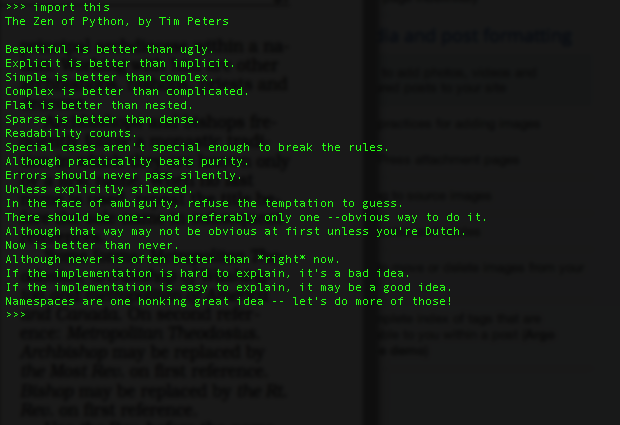

Thus, when presented with a scenario in which you have two working pieces of code, you should opt for the one that is simpler, more readable, and easier to understand. We have an unnecessary else condition in our collatz function that can be removed as follows: def collatz(num):
Zen of python code#
The code above works perfectly fine, but it is not necessarily beautiful. Initial code was created by Vishal Sharma A simple rule of thumb to keep you in check is to write clean, readable code that can be easily understood by other developers. What is beautiful code? Well, it is subjective - beauty is in the eye of the beholder and all that jazz. As a Python developer, you have a responsibility to maintain the pythonic standard by writing beautiful code. Python’s rapid rise to fame is partly due to its accessibility: it is simple, readable, and elegant. The ability to solve problems with code is not an easy task, but as a Pythonista, more is expected of you. If you are a programmer, there is no doubt that you are highly skilled. In this article, we are going to cover each lesson in more detail.

Namespaces are one honking great idea - let's do more of those! If the implementation is easy to explain, it may be a good idea. If the implementation is hard to explain, it's a bad idea. There should be one- and preferably only one -obvious way to do it.Īlthough that way may not be obvious at first unless you're Dutch.Īlthough never is often better than *right* now. In the face of ambiguity, refuse the temptation to guess. Special cases aren't special enough to break the rules. If you ever forget the lessons, you can easily refresh your memory by running import this from the Python interpreter.

Following the Zen of Python is not compulsory, but knowing it and keeping it in mind is advised. Guido reportedly stated that the missing twentieth aphorism is “some bizarre Tim Peters inside joke.”ĭespite the missing twentieth aphorism, the Zen of Python was standardized as PEP 20 in 2004 due to its heavy influence on Python programmers' development process. It was actually supposed to be twenty aphorisms but Guido van Rossum, the creator of Python, has still not added the final aphorism as intended by Tim Peters, the creator of the Zen of Python. The Zen of Python is a set of nineteen aphorisms that serve as guiding principles for Python’s design.


 0 kommentar(er)
0 kommentar(er)
